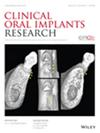自主机器人手术与动态导航在种植体植入中的准确性:一项开放标签、双臂、随机对照临床试验
IF 5.3
1区 医学
Q1 DENTISTRY, ORAL SURGERY & MEDICINE
引用次数: 0
摘要
目的比较在同一光学跟踪系统下,在标准化条件下,自主机器人动态导航在种植体植入中的准确性和临床效果。方法一项前瞻性开放标签随机对照试验,双平行臂,纳入40例单颗缺牙患者。参与者被随机分配到自主机器人组(AR组,n = 20)或动态导航组(DN组,n = 20)进行种植。两组手术系统采用相同的光学跟踪技术。准确性分析的主要参数是计划种植体位置与实际种植体位置之间的角度、冠状和根尖偏差。次要结局包括手术时间、患者报告的疼痛、水肿、并发症和早期种植成功率。结果AR组种植体的角度偏差(1.01°±0.65°)明显低于DN组(1.78°±1.15°,p < 0.01)。冠状和根尖种植体偏差无统计学差异。机器人手术时间更长(21.52±9.81 min vs. 14.27±3.57 min, p < 0.01)。两组术后疼痛、水肿、并发症和早期种植成功率比较。结论在本研究的局限性下,与动态导航相比,自主机器人获得了更好的种植体放置角度精度;然而,与线性偏差相关,没有统计学上的显著差异。中国临床试验注册号:ChiCTR2400085659本文章由计算机程序翻译,如有差异,请以英文原文为准。
The Accuracy of Autonomous Robotic Surgery vs. Dynamic Navigation in Implant Placement: An Open‐Label, Double‐Arm, Randomized Controlled Clinical Trial
ObjectivesThis study aimed to compare the accuracy and clinical outcomes of an autonomous robot with dynamic navigation in implant placement under standardized conditions, with the same optical tracking system.MethodsA prospective open‐label randomized controlled trial with two parallel arms enrolled 40 patients with a single tooth missing. Participants were randomly allocated to either the autonomous robot group (AR group, n = 20) or the dynamic navigation group (DN group, n = 20) for implant placement. The surgical systems of these two groups utilized the same optical tracking technology. The primary parameters for accuracy analysis were angular, coronal, and apical deviations between planned and actual implant positions. Secondary outcomes included surgical time, patient‐reported pain, edema, complications, and early implant success rate.ResultsThe AR group demonstrated significantly lower angular deviation of implants (1.01° ± 0.65°) compared to the DN group (1.78° ± 1.15°, p < 0.01). There was no statistically significant difference found in coronal and apical implant deviations. Surgical time was longer for robotic procedures (21.52 ± 9.81 min vs. 14.27 ± 3.57 min, p < 0.01). Postoperative pain, edema, complications, and early implant success rate were comparable between the two groups.ConclusionWithin the limitations of this study, the autonomous robot achieved superior angular accuracy of implant placement compared to dynamic navigation; however, there was no statistically significant difference in relation to linear deviations.Trial RegistrationChinese Clinical Trial Registry number: ChiCTR2400085659
求助全文
通过发布文献求助,成功后即可免费获取论文全文。
去求助
来源期刊

Clinical Oral Implants Research
医学-工程:生物医学
CiteScore
7.70
自引率
11.60%
发文量
149
审稿时长
3 months
期刊介绍:
Clinical Oral Implants Research conveys scientific progress in the field of implant dentistry and its related areas to clinicians, teachers and researchers concerned with the application of this information for the benefit of patients in need of oral implants. The journal addresses itself to clinicians, general practitioners, periodontists, oral and maxillofacial surgeons and prosthodontists, as well as to teachers, academicians and scholars involved in the education of professionals and in the scientific promotion of the field of implant dentistry.
 求助内容:
求助内容: 应助结果提醒方式:
应助结果提醒方式:


